
Global Leaders Convene in New York for Pivotal “Summit of the Future”
On Sunday, global leaders are gathering in New York for the highly anticipated “Summit of the Future,” a meeting designed to address some of the most pressing 21st-century challenges, from escalating global conflicts to the climate crisis. The summit, initiated by United Nations Secretary-General Antonio Guterres, seeks to rekindle international cooperation and reshape global governance. However, despite its ambitious goals, there is widespread skepticism over whether the resulting “Pact for the Future” will meet expectations.
A “Once-in-a-Generation Opportunity”
Originally proposed by Guterres in 2021, the summit has been touted as a pivotal moment in international diplomacy. The Secretary-General described it as a “once-in-a-generation opportunity” to reshape human history and restore international cooperation. As part of the opening act for the UN General Assembly’s annual high-level week, which starts on Tuesday, dozens of heads of state and government are expected to adopt a “Pact for the Future.”
Yet, even as the summit kicks off, Guterres has voiced concerns about the negotiations. After weeks of intense discussions, the Secretary-General urged nations to display “vision” and “courage” to ensure the final agreement is meaningful. He called for “maximum ambition” to reform international institutions, many of which have struggled to address today’s complex global threats.
The “Pact for the Future”
The draft of the “Pact for the Future,” which will be put forward for adoption, emphasizes the need for a revitalized multilateral system to “keep pace with a changing world” and to protect the interests of current and future generations. Spanning nearly 30 pages, the pact outlines 56 key actions, including commitments to upholding the UN Charter, reinforcing peacekeeping efforts, and addressing global crises.
Among its most notable provisions are calls for reforms to international financial institutions and the UN Security Council, stronger action on climate change, disarmament initiatives, and strategies for managing artificial intelligence. “We believe there is a path to a brighter future for all of humanity,” reads the document’s preamble.
Criticism Over Ambition
Despite the sweeping scope of the agreement, there is notable disappointment among diplomats and international observers. Richard Gowan, an expert from the International Crisis Group, said that while the text contains “good ideas,” it falls short of the transformative change Guterres initially envisioned. “It is not the sort of revolutionary document reforming the whole of multilateralism that Antonio Guterres had originally called for,” Gowan remarked.
Diplomats echoed this sentiment, with some describing the pact as “lukewarm” and “the lowest common denominator.” According to one anonymous diplomat, “You would hope for new, fresh ideas. You know, 2.0 and then some. But when you have 200 countries that all have to agree, you end up with a Christmas tree of everything.”
In particular, negotiations have been tense in recent days. Russia has raised objections to the final version of the text, a diplomatic source told AFP, casting doubt over whether the pact will be adopted without further amendments. Climate change has also been a key point of contention. Early drafts had removed references to the “transition” away from fossil fuels, but these were later reinserted after backlash from negotiators.
Opportunities and Concerns
Despite these hurdles, many still see the summit as a crucial opportunity to reaffirm global commitments to multilateralism, especially in the face of current geopolitical tensions. A Western diplomat highlighted the importance of the summit in rebuilding trust between the Global North and South, particularly as developing countries seek concrete reforms in the international financial system. These nations are pushing for easier access to preferential financing, especially as they grapple with the growing impacts of climate change.
Human Rights Watch (HRW) noted that the pact includes “important commitments on economic justice and reforming the international financial architecture” and commended the focus on human rights. However, HRW’s UN Director, Louis Charbonneau, stressed that world leaders “still need to demonstrate that they are willing to act to uphold human rights.”
Moving from Words to Action
One of the major criticisms of the “Pact for the Future” is its non-binding nature. Although the text and its annexes — which include a Global Digital Compact and a Declaration on Future Generations — contain many important principles, such as the protection of civilians in conflict zones, their implementation remains uncertain. Critics have pointed out that several key international norms are violated daily, raising concerns about whether the pact’s commitments will be upheld.
UN Secretary-General Guterres has acknowledged these concerns, urging world leaders to ensure that the pact becomes more than just a list of aspirations. “Our next task is to breathe life into them, to turn words into action,” Guterres said on Saturday, emphasizing that the real challenge will be implementing the agreement in the years ahead.
As the “Summit of the Future” unfolds, the world will be watching to see if global leaders can rise to the occasion and take decisive action to address the most urgent threats facing humanity.
- Nepal’s Exports Rise by 16.5% in Five Months Amid Trade Deficit
- Cabinet Decisions: DIGs Singh and Bohara Promoted; Key Policy Changes Approved
- High-Level Meeting Held to Address Nepal’s Anti-Money Laundering Challenges
- China Imposes Sanctions on Canadian Institutions and Individuals Over Uyghur and Tibet Issues













Comments